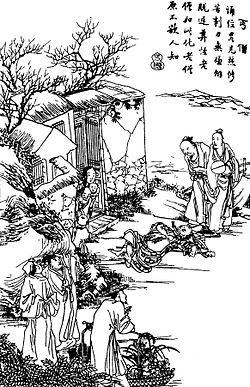
Summary
"This Transformation", also known as "The Begging Monk", (Chinese: 丐僧; pinyin: Gaì Sēng) is a short story by Pu Songling collected in Strange Stories from a Chinese Studio (1740). The tale revolves around a monk who begs for nothing in particular and is treated like an outcast. It was first fully translated into English by John Minford in 2006, followed by Sidney L. Sondergard in 2008.
| "This Transformation" | |||
|---|---|---|---|
| Short story by Pu Songling | |||
 19th-century illustration from Xiangzhu liaozhai zhiyi tuyong (Liaozhai Zhiyi with commentary and illustrations; 1886) | |||
| Original title | 丐僧 (Gaiseng) | ||
| Translator | John Minford | ||
| Country | China | ||
| Language | Chinese | ||
| Genre(s) | Zhiguai | ||
| Publication | |||
| Published in | Strange Stories from a Chinese Studio | ||
| Publication type | Anthology | ||
| Publication date | c. 1740 | ||
| Published in English | 2006 | ||
| Chronology | |||
| |||
Plot edit
A reclusive and shabby-looking monk skulks the streets of Jinan, reciting aloud sutras and begging for alms; however, he rejects everything people offer to him, be it food or water. Enquiries on the reason for such, as well as suggestions to relocate to a less-populated area, are ignored, until one day the monk angrily stresses that: "This is the transformation I'm seeking."[1][a] Some time afterwards, the monk is spotted lying near the southern border, motionless to the extent of being corpse-like. The locals try to get a reaction from him, with some criticising the monk; enraged, he gets up and disembowels himself with a short knife.[3] He is quickly buried but when his coffin is unearthed, the corpse is nowhere to be found.[3]
Reception edit
Sidney L. Sondergard, who included the story in the second volume of his translation of the 494 entries in Strange Tales from a Chinese Studio, suggests that it is criticizing people who are not receptive towards the feelings of others, in this case the titular "begging monk"; in real life, Pu Songling was reportedly misunderstood by many.[4] Zhang Zhongliang concurs with this view, writing that "This Transformation" highlights the social othering suffered by beggars.[5] A writer for Wenshi Zhishi (文史知识), a Chinese literature-based circular, compares the begging monk to a Buddhist character in Dream of the Red Chamber.[6]
See also edit
- China portal
- Religion portal
- Speculative fiction portal
References edit
Notes edit
Citations edit
- ^ Minford 2006, p. 258.
- ^ Sondergrad 2008, p. 413.
- ^ a b Minford 2006, p. 259.
- ^ Sondergrad 2008, p. 14.
- ^ Zhang 2007, p. 203.
- ^ Wenshi Zhishi 2007, p. 84.
Bibliography edit
- Minford, John (2006). Strange Tales from a Chinese Studio. Penguin Books. ISBN 9780140447408.
- Sondergrad, Sidney (2008). Strange Tales from Liaozhai. Jain Publishing Company. ISBN 9780895810519.
- 文史知识 [History of Literature] (in Chinese). Chinese Publications. 2007.
- Zhang, Zhongliang (2007). 濟公故事綜合研究 [General analysis of works by Pu Songling] (in Chinese). Xiuwei Publications. ISBN 9789866909542.


